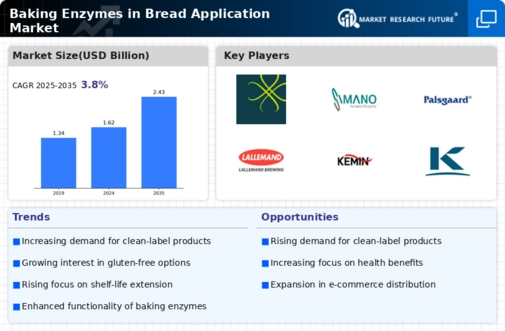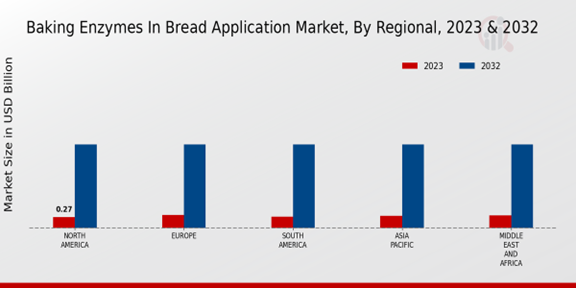Market Growth Projections
The Global Baking Enzymes in Bread Application Market Industry is poised for substantial growth, with projections indicating a market value of 1.62 USD Billion in 2024 and an anticipated increase to 2.43 USD Billion by 2035. This growth trajectory is supported by a compound annual growth rate of 3.75% from 2025 to 2035. Factors contributing to this expansion include rising consumer demand for processed foods, technological advancements in enzyme production, and increasing health consciousness among consumers. The market's evolution reflects broader trends in the food industry, where quality, convenience, and sustainability are becoming paramount.
Health and Wellness Trends
The increasing focus on health and wellness among consumers significantly influences the Global Baking Enzymes in Bread Application Market Industry. With a growing awareness of the importance of nutrition, consumers are gravitating towards bread products that offer health benefits, such as higher fiber content and lower glycemic indices. Enzymes play a crucial role in enhancing the nutritional profile of bread, making it more appealing to health-conscious individuals. This trend is likely to drive market growth, as manufacturers leverage enzymes to create healthier bread options. The anticipated compound annual growth rate of 3.75% from 2025 to 2035 underscores the potential for growth in this sector.
Sustainability Initiatives
Sustainability initiatives are increasingly shaping the Global Baking Enzymes in Bread Application Market Industry. As consumers become more environmentally conscious, there is a growing demand for sustainable production practices in the food industry. Baking enzymes contribute to sustainability by improving the efficiency of bread production, reducing waste, and minimizing the carbon footprint. For example, enzymes can enhance dough fermentation, leading to shorter baking times and lower energy consumption. This alignment with sustainability goals not only appeals to eco-conscious consumers but also positions manufacturers favorably in a competitive market. The ongoing commitment to sustainability is expected to drive further growth in the market.
Rising Demand for Processed Foods
The Global Baking Enzymes in Bread Application Market Industry experiences a notable surge in demand for processed foods, driven by changing consumer lifestyles and preferences. As urbanization increases, consumers seek convenient food options that do not compromise on quality. This trend is reflected in the projected market value of 1.62 USD Billion in 2024, indicating a robust growth trajectory. Processed bread products, enhanced with enzymes, offer improved texture, shelf life, and nutritional value, appealing to health-conscious consumers. Consequently, manufacturers are increasingly incorporating baking enzymes to meet these evolving demands, thereby propelling the market forward.
Regulatory Support for Food Safety
Regulatory support for food safety is a critical driver of the Global Baking Enzymes in Bread Application Market Industry. Governments worldwide are implementing stringent regulations to ensure food safety and quality, which in turn influences the use of baking enzymes. These regulations often encourage the adoption of enzymes that enhance the safety and shelf life of bread products. Compliance with food safety standards can lead to increased consumer trust and brand loyalty, ultimately benefiting manufacturers. As the market evolves, regulatory frameworks are likely to adapt, further promoting the use of baking enzymes in bread production.
Technological Advancements in Baking
Technological advancements play a pivotal role in shaping the Global Baking Enzymes in Bread Application Market Industry. Innovations in enzyme formulations and production processes enhance the efficiency and effectiveness of baking enzymes. For instance, the development of specific enzymes tailored for various bread types, such as gluten-free or whole grain, caters to niche markets. These advancements not only improve the quality of bread but also reduce production costs, making it more accessible to consumers. As a result, the market is expected to grow significantly, with a projected value of 2.43 USD Billion by 2035, reflecting the impact of technology on consumer preferences and production capabilities.




















Leave a Comment